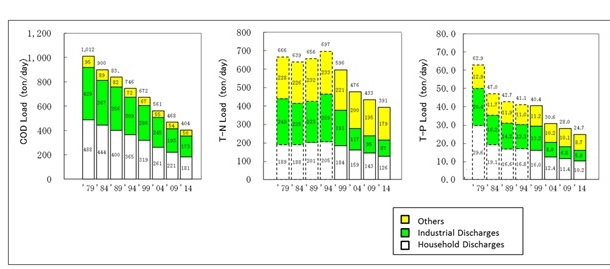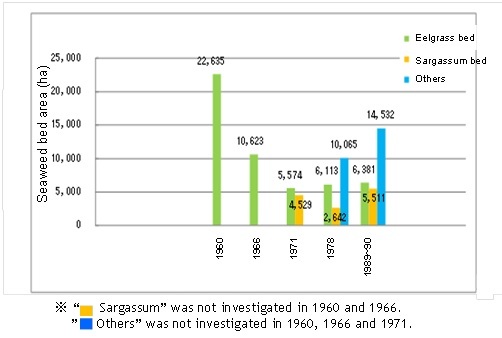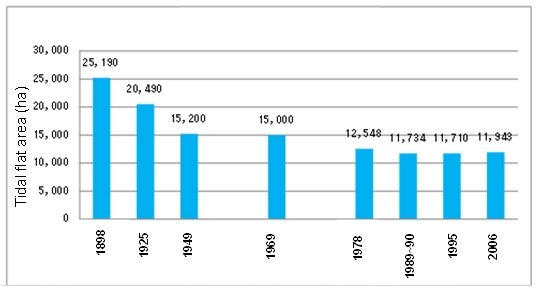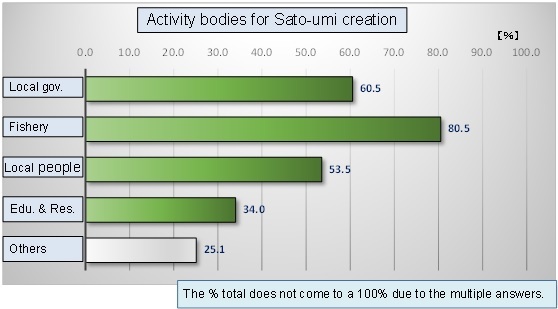BISAC NAT010000 Ecology
BISAC NAT045050 Ecosystems & Habitats / Coastal Regions & Shorelines
BISAC NAT025000 Ecosystems & Habitats / Oceans & Seas
BISAC NAT045030 Ecosystems & Habitats / Polar Regions
BISAC SCI081000 Earth Sciences / Hydrology
BISAC SCI092000 Global Warming & Climate Change
BISAC SCI020000 Life Sciences / Ecology
BISAC SCI039000 Life Sciences / Marine Biology
BISAC SOC053000 Regional Studies
BISAC TEC060000 Marine & Naval
The Seto Inland Sea, the largest enclosed sea in Japan, has unrivalled beauty of archipelago and abundant nature under temperate climate with light rain falls, and the people has been benefitted from the sea ever since the early times. We however experienced sever water pollution problems caused by rapid industrialization and the loss of seaweed bed and tidal flat due to reclamation projects particularly in the period of the high economic growth in 1960s. To resolve these issues, we have carried out water quality improvement programs including reduction of pollutant load based upon the Water Pollution Control Law and the Law concerning Special Measures for Conservation of the Environment of the Seto Inland Sea. As a result, water quality has improved as compared with Tokyo Bay and other enclosed seas. However, there are still severe problems including the occurrence of red tide and oxygen deficient water mass in some areas in the Seto Inland Sea. Securing the bio-diversity, bio-productivity and smooth nutrient circulation are also important. Under these situations, the Law and the Basic Plan for Conservation of the Environment of the Seto Inland Sea were revised in 2015. With these law and plan, it has been made clear that our principal objective is to make the Seto Inland Sea a “Bountiful Sea” through conservation of water quality with bio-diversity and bio-productivity. Also the importance to implement environmental measures corresponding local differences in the respective region and seasonality were indicated. In order to actualize “the Beautiful and Bountiful Seto Inland Sea”, we need to implement environmental water management as follows. 1. Environmental conservation, restoration and creation of coastal areas. 2. Conservation and management of water quality. 3. Conservation of natural and cultural landscapes. 4. Sustainable utilization of fishery resources. Ministry of the Environment, Japan will continue to conduct corresponding programs based on scientific survey and evaluation on conservation/restoration of seaweed bed, tidal flat, smooth circulation of nutrients.
Coastal management policy, Seto Inland Sea, Sato-umi, Bio-diversity, Bio-productivity
The Seto Inland Sea, the largest enclosed sea in Japan, has unrivalled beauty of archipelago and abundant nature under temperate climate with light rain falls, and the people has been benefitted from the sea ever since the early times. We however experienced sever water pollution problems caused by rapid industrialization and the loss of seaweed bed and tidal flat due to reclamation projects particularly in the period of the high economic growth in 1960s. To resolve these issues, we have carried out water quality improvement programs including reduction of pollutant load based upon the Water Pollution Control Law and the Law concerning Special Measures for Conservation of the Environment of the Seto Inland Sea. As a result, water quality has improved as compared with Tokyo Bay and other enclosed seas.
However, there are still severe problems including the occurrence of red tide and oxygen deficient water mass in some areas in the Seto Inland Sea. Securing the bio-diversity, bio-productivity and smooth nutrient circulation are also important. Under these situations, the Law and the Basic Plan for Conservation of the Environment of the Seto Inland Sea were revised in 2015. With these law and plan, it has been made clear that our principal objective is to make the Seto Inland Sea a “Bountiful Sea” through conservation of water quality with bio-diversity and bio-productivity. Also the importance to implement environmental measures corresponding local differences in the respective region and seasonality were indicated.
In order to actualize “the Beautiful and Bountiful Seto Inland Sea”, we need to implement environmental water management as follows.
1. Environmental conservation, restoration and creation of coastal areas.
2. Conservation and management of water quality.
3. Conservation of natural and cultural landscapes.
4. Sustainable utilization of fishery resources.
Ministry of the Environment, Japan will continue to conduct corresponding programs based on scientific survey and evaluation on conservation/restoration of seaweed bed, tidal flat, smooth circulation of nutrients.

Fig.1: Location of major enclosed sea in Japan
1. Introduction
Enclosed seas are mostly surrounded by land, so they are serene, accessible and bountiful, and closely related and contribute to people’s lives. On the other hand, after the high economic growth in 1960s, we experienced water pollution which caused serious problems including the damages to aquatic creatures and fishery, as the seas being prone to accumulate organic pollutants and nutrients off the land due to low level of sea water circulation under their topographic features.
2. Circumstances and challenges in the Seto Inland Sea
The Seto Inland Sea, the largest enclosed coastal sea in Japan, experienced various water pollution problems including the damages to aquatic creatures and fishery after the high economic growth in 1960s. To resolve this situation, we introduced in 1973 the Law concerning Interim Measures for Conservation of the Environment of the Seto Inland Sea, which was revised in 1978 into a permanent law. Based upon the Law, permission system for establishment of the facilities flowing out effluents into the public waters and containment of reclamation programs were enforced. Besides, we have implemented TPLCS in order to reduce pollutants of COD, TN and TP flowing into the Sea.
With these measures combined, the area of reclamation has been strongly reduced after the Law was enacted, and COD, TN and TP loads have been steadily reduced. The annual red tide occurrences in the Seto Inland Sea was about 300 cases around 1975 but it decreased to around 100 cases in the late 1980s, and this level has remained to date.

Fig. 2: Reclamation area in the Seto Inland Sea

Fig. 3: Reduction of COD, T-N and T-P Load in the Seto Inland Sea\

Fig. 4: Occurrences of red tide in the Seto Inland Sea
However, there are still severe problems including the occurrence of red tide and oxygen deficient water mass in some areas in the Seto Inland Sea. Another issue is the loss of many seaweed beds and tidal flats where various creatures live and breed. The area of eelgrass field, a type of seaweed bed, disappeared by about 70% from 1960 to 1989/1990, and likewise that of tidal flats disappeared by about 50% from 1898 to 2006. Moreover, what has been pointed out is the issue of securing bio-diversity and bio-productivity as shown in the catch which registered a peak of 485,000 tons in 1985, but it was down to its one-third level of 175,000 tons in 2011. Regarding the decline in the catch, we yet come to know the conclusive reasons because of our limited scientific knowledge while some people believe that the decrease of nutrients including nitrogen and phosphorus might have something to do with it.

Fig. 5(a): Change of seaweed bed in the Seto Inland Sea

Fig. 5(b): Change of tidal flat in the Seto Inland Sea
- Revision of the Law and the Basic Plan to actualize the beautiful and bountiful Sea
Revision of the Law
Under these circumstances, the Law concerning Special Measures for Conservation of the Environment of the Seto Inland Sea was revised in 2015. In the revised Law, the basic concept of environmental conservation for the Sea was indicated. The concept has made it clear to make the Seto Inland Sea a beautiful and bountiful sea or “Sato-umi,” a coastal area where bio-diversity and bio-productivity has increased through human interaction. Also emphasized is the importance to proceed with the concept in a comprehensive and planned manner in implementation of the works to realize the bountiful Seto Inland Sea in addition to the pollutant controlling measures in the coastal areas including seaweed beds and tidal flats. Moreover, we are supposed to carry out those measures in good considerations into the environmental differences by region and seasonality.
Another important point reflected in the revised Law is the fact that we yet have decisive conclusion based on satisfactory level of scientific knowledge on the cause of the decreased catch of fishery while some people believe nutrients like nitrogen and phosphorus have something to do with the catch of fishery. We therefore should conduct investigations into the facts around the nutrients in the Sea, studies on the correlation of the nutrients affecting the fishery resources, surveys and studies on proper management of the nutrients. And, depending on the findings of those activities, we are supposed to study the administrative ways for the nutrients in the Sea and set necessary measures to manage them in timeframe of a five-year after the enactment of the revised Law.
Revision of the Basic Plan
The Basic Plan for Conservation of the Environment of the Seto Inland Sea was revised in 2015 for the first time in 14 years. The Plan which is set by the government based upon the Law is of fundamentally positioned for environmental conservation of the Seto Inland Sea. Its first version was set in 1978, and changed for three times since then. In the change made in 2015, it has been made clear to bring about a “Bountiful sea” where bio-diversity and bio-productivity should be secured in addition to the preservation of water quality in satisfactory conditions. Likewise emphasized is the importance to implement measures with good respect of the differences in the respective region and in seasonality just reflecting the concepts set in the revised Law. The emphasized administrative directions in the change of the plan are as follows.
- New concept of “Conservation, Restoration and Creation of coastal environment” including seaweed beds and tidal flats in view of bio-diversity and bio-productivity depending upon the idea of “the Bountiful Seto Inland Sea.”
- New perspective of “management” in water quality preservation reflecting the importance of locality and seasonality besides the preventive measures against water pollution.
- New administrative objective of “Securing sustainable use of fishery resources” as fishery resources are indispensable components but finite in bio-system in the view point of bio-diversity.
- New system to check on the progress by setting the duration of the plan of 10 years with the interim checking point at the time of five years while the former plans had not such system of interim progress checks.
.jpg)
Fig. 6: Point of the revision of the Basic Plan
- Measures to actualize the beautiful and bountiful Sea
Surveys and investigations
In order to actualize “the Beautiful and Bountiful Sea” written in the Law and the Basic Plan, the most important is to properly evaluate the circumstance of the environment in the region based on the scientific knowledge. Along this thought, MOE has been engaged in the following surveys and investigations.
- Distribution survey of seaweed beds and tidal flats
Seaweed beds and tidal flats are vital to a variety of aquatic creatures to live and breed, and periodic survey is indispensable to evaluate changes in them over the time. We conduct surveys utilizing the advancing analytical technology of satellite images for effective and quantitative grip of the distribution changes over the extensive area of the Sea.
- Study on the measures for management responding to the differences by region
In study on the administrative measures to secure beautiful and bountiful sea, critical is to evaluate the circumstance of water quality, sediment as well as bio-diversity/bio-productivity. We therefore conduct surveys and analysis into sediment, benthos and so forth, and identify regional issues and also seasonality so that we should be able to proceed with a variety of measures to secure beautiful and bountiful seas.
- Study on the influence of climate change
It has been pointed out that the climate changes have affected the water quality, sediment, bio-diversity and bio-productivity, the change as exemplified in the data showing water temperature increase by one degree Celsius in the last 30 years in the Seto Inland Sea. Also pointed out is that discoloration of cultured laver might be caused by the increase of phytoplankton under the rising temperature, in particular by large diatoms including Eucampia zodiacus. Since the understanding on the influence of climate changes is indispensable in study on future administrative measures in the Sea, MOE plans to conduct the survey and investigation about the influence over the water quality.
Promotional activities for creation of Sato-umi
In environmental conservation for enclosed coastal seas including the Seto Inland Sea, important is the works to bring about “bountiful sea”, the works such as activities carried out by various people and organizations in local communities, conservation, restoration and creation of favorable coastal environment like seaweed beds and tidal flats. In Japan, a package of those works is called “Activities for Sato-umi creation.” Sato-umi is the coastal sea area where proper circulative function of nutrient materials and various ecosystems are favorably preserved by people through holistic and integral management over coastal sea areas combined with its neighboring land areas, bringing us with many blessings. We have many such Sato-umi activities carried out by various groups of local people.
MOE surveyed those Soto-umi creation activities throughout Japan both in 2010 and 2014. One of the findings out of the questionnaire was the number of those activities, 122 cases in 2010 versus 216 in 2014, a twofold growth over the four years, a good sign that the activities have been well popularized. The survey also showed that the people involved in the activities were not only of administrative organization but also from various sectors including fishery, local community, educational and research organization. Moreover, we came to recognize that the activities had such a wide scope as conservation, restoration and creation of seaweed beds and tidal flats, conservation and restoration of fishery sites and containment of litter. MOE intends to further spread and promote the activities through the manuals for the activities, publication of the excellent activities on our web site and so forth.

Fig. 7(a): Activity bodies for Sato-umi creation in Japan

Fig. 7(b): Wide variation in the activities
- Conclusion
Beautiful and bountiful seas should be passed down to the people in the future as the scenic beauty with landscapes of natural and cultural views as well as the treasury of fishery resources. MOE will continue to be engaged in various measures to secure “Beautiful and bountiful seas.” In so doing, it is important to evaluate the circumstance in scientific point of views through comprehensive and integral survey and investigation into aquatic environmental facts including nutrients, plankton, aquatic creatures and climate change. We also need to continue proper partnership with such various people in related ministries/agencies, local administrative entities, academic, fishery, NPOs and business. We will meanwhile continue to work on conservation and restoration of enclosed coastal seas through sharing our experience in Sato-umi creation activities and information exchange.
1. MOE Sato-umi Net, http://www.env.go.jp/water/heisa/satoumi/en/index_e.html







